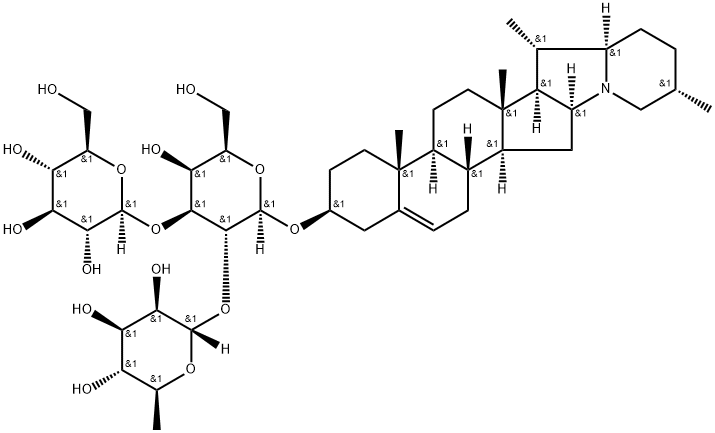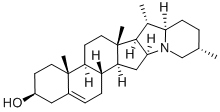alpha-Solanine
Synonym(s):alpha-Solanine
- CAS NO.:20562-02-1
- Empirical Formula: C45H73NO15
- Molecular Weight: 868.07
- MDL number: MFCD00077873
- EINECS: 243-879-8
- SAFETY DATA SHEET (SDS)
- Update Date: 2024-11-06 18:33:45

What is alpha-Solanine ?
Description
This steroidal alkaloid is present in several Solanum species including S. nigrum,
S. Iycopersicum (tomato) and S. tuberosum (potato). The base crystallizes in
slender needles and shrinks markedly at 235°C. It has [α]20D - 59.45° (pyridine)
or - 42.16° (dilute HCl) and is readily soluble in hot EtOH, sparingly so in H20
and virtually insoluble in CHCl 3 or Et2 0. The salts are mostly amorphous
although a crystalline hydrochloride has been prepared with m.p. 212°C (dec.).
It is not affected by alkalies but mineral acids hydrolyze it to solanidine (q.v.)
and one mole each of dextrose, galactose and rhamnose.
Pharmacologically, the alkaloid is a protoplasmic poison and a powerful
haemolytic. Poisoning by potatoes sometimes occurs although the results are not
usually fatal. The symptoms are nausea, headache, emesis and gastritis. With
large doses parenchymatous nephritis and haemoglobinuria occurs with, at times,
paralysis of the central nervous system and cardiac arrest. The alkaloid also
possesses local irritant properties.
Chemical properties
White solid
The Uses of alpha-Solanine
α-Solanine is produced as a by product in the synthesis of α-Chaconine. α-Chaconine is a glycoalkaloid displaying nerve toxin activity. Potential antifungal activity.
What are the applications of Application
α-Solanine is a trisaccharide, consisting of glucose, galactose and rhamnose, linked to solanidine.
Definition
ChEBI: A glycoalkaloid poison found in species of the nightshade family (Solanaceae), such as the potato (Solanum tuberosum). It is a trisccharide derivative of solanidine [(22beta)-solanid-5-en-3beta-ol].
Benefits
It has been revealed that α-solanine possesses potential chemotherapeutic action against cancers in several organs, including lung, breast, esophagus, prostate, and liver, as well as acute lymphocytic leukemia. α-solanine also has potential anti-inflammatory properties[1].
General Description
This substance is a primary reference substance with assigned absolute purity (considering chromatographic purity, water, residual solvents, inorganic impurities). The exact value can be found on the certificate. Produced by PhytoLab GmbH & Co. KG
Hazard
A poison.
Mechanism of action
In vitro studies have shown that alpha-Solanine's anti-cancer mechanism of action is induction of apoptosis, inhibition of cell proliferation and angiogenesis[1]. It also regulates the nuclear factor-κB (NF-κB) signalling pathway in tumour cells and macrophages[2].
Side Effects
A small amount of α-solanine can cause common symptoms such as dizziness, nausea, abdominal pain, vomiting, and diarrhea. Excessive consumption of α-solanine can lead to convulsions, coma, and even death. Animal studies have shown that α-solanine can damage the reproductive system[1].
Toxicology
alpha-Solanine is the major glycoalkaloid in the potato plant and is toxic. Potatoes generally contain toxic alpha-Solanine when they have been left for a long period of time resulting in a greenish colouration of the surface. Poisoning after ingestion is manifested by nausea, vomiting, diarrhoea, abdominal pain, fever or below normal body temperature (hypothermia), slow pulse and/or respiration, and confusion.
Purification Methods
Recrystallise -solanine from EtOH, 85% aqueous EtOH, MeOH or aqueous MeOH as dihydrate m 276-278o. It solubility in H2O is 25mg/L and 5% in pyridine, but it is very soluble in Et2O and CHCl3. The hydrochloride is gummy or amorphous but has been crystallised (m ~212o dec). It has insecticidal properties. [Kuhn et al. Chem Ber 88 1492 1955, Beilstein 21 III/IV 1402.]
References
Desfosses.,lahresb., 2, 114 (1820)
Firbas., Monatsh., 10, 541 (1889)
Cazeneuve, Breteau., Compt. rend., 128,887 (1899)
Davis., Pharm. I., 15, 160 (1902)
Wittman., Monatsh., 26,445 (1905)
Colombano., Gazzetta, 38, 19 (1908)
Zemplen, Gerecs., Ber., 61,2294 (1928)
Schopf, Herrmann., ibid, 66, 298 (1933)
Oddo, Caronna., ibid, 67,446 (1934)
References
[1] Zhilong Chen. “α-Solanine Causes Cellular Dysfunction of Human Trophoblast Cells via Apoptosis and Autophagy.” Toxins (2021).
References
[1] MARYAM MOHSENIKIA . The protective and therapeutic effects of alpha-solanine on mice breast cancer[J]. European journal of pharmacology, 2013. DOI:10.1016/j.ejphar.2013.09.015.
[2] NAN WANG. Alpha-solanine inhibits endothelial inflammation via nuclear factor kappa B signaling pathway.[J]. Advances in Clinical and Experimental Medicine, 2023. DOI:10.17219/acem/158781.
Properties of alpha-Solanine
| Melting point: | 285℃ (dec.) |
| Boiling point: | 780.78°C (rough estimate) |
| Density | 1.40±0.1 g/cm3 (20 ºC 760 Torr) |
| refractive index | 1.5280 (estimate) |
| storage temp. | −20°C |
| solubility | Methanol (Slightly, Heated), Pyridine (Slightly, Sonicated), Water (Slightly, He |
| form | Solid |
| pka | 6.66(at 15℃) |
| color | White to Off-White |
| Water Solubility | 26.04mg/L(15 ºC) |
| Merck | 13,8779 |
| BRN | 77607 |
Safety information for alpha-Solanine
| Signal word | Warning |
| Pictogram(s) |
 Exclamation Mark Irritant GHS07 |
| GHS Hazard Statements |
H302:Acute toxicity,oral |
| Precautionary Statement Codes |
P264:Wash hands thoroughly after handling. P264:Wash skin thouroughly after handling. P270:Do not eat, drink or smoke when using this product. P501:Dispose of contents/container to..… |
Computed Descriptors for alpha-Solanine
| InChIKey | ZGVSETXHNHBTRK-MUEWWJAYNA-N |
New Products
4-Fluorophenylacetic acid 4-Methylphenylacetic acid N-Boc-D-alaninol N-BOC-D/L-ALANINOL Tert-butyl bis(2-chloroethyl)carbamate 3-Morpholino-1-(4-nitrophenyl)-5,6-dihydropyridin- 2(1H)-one Furan-2,5-Dicarboxylic Acid Tropic acid S-2-CHLORO PROPIONIC ACID ETHYL ISOCYANOACETATE 2-Bromo-1,3-Bis(Dimethylamino)Trimethinium Hexafluorophosphate (6-METHYL-[1,3]DITHIOLO[4,5-b]QUINOXALIN-2-ONE INDAZOLE-3-CARBOXYLIC ACID 4-IODO BENZOIC ACID (2-Hydroxyphenyl)acetonitrile 4-Bromopyrazole 5,6-Dimethoxyindanone 2-(Cyanocyclohexyl)acetic acid 4-methoxy-3,5-dinitropyridine 2-aminopropyl benzoate hydrochloride 1-(4-(aminomethyl)benzyl)urea hydrochloride diethyl 2-(2-((tertbutoxycarbonyl)amino) ethyl)malonate tert-butyl 4- (ureidomethyl)benzylcarbamate Ethyl-2-chloro((4-methoxyphenyl)hydrazono)acetateRelated products of tetrahydrofuran








You may like
-
 α-Solanine CAS 20562-02-1View Details
α-Solanine CAS 20562-02-1View Details
20562-02-1 -
 α-Solanine CAS 20562-02-1View Details
α-Solanine CAS 20562-02-1View Details
20562-02-1 -
 1975-50-4 98%View Details
1975-50-4 98%View Details
1975-50-4 -
 2-HYDROXY BENZYL ALCOHOL 98%View Details
2-HYDROXY BENZYL ALCOHOL 98%View Details
90-01-7 -
 2-Chloro-1,3-Bis(Dimethylamino)Trimethinium Hexafluorophosphate 221615-75-4 98%View Details
2-Chloro-1,3-Bis(Dimethylamino)Trimethinium Hexafluorophosphate 221615-75-4 98%View Details
221615-75-4 -
 61397-56-6 CIS BROMO BENZOATE 98%View Details
61397-56-6 CIS BROMO BENZOATE 98%View Details
61397-56-6 -
 14714-50-2 (2-Hydroxyphenyl)acetonitrile 98+View Details
14714-50-2 (2-Hydroxyphenyl)acetonitrile 98+View Details
14714-50-2 -
 118753-70-1 98+View Details
118753-70-1 98+View Details
118753-70-1